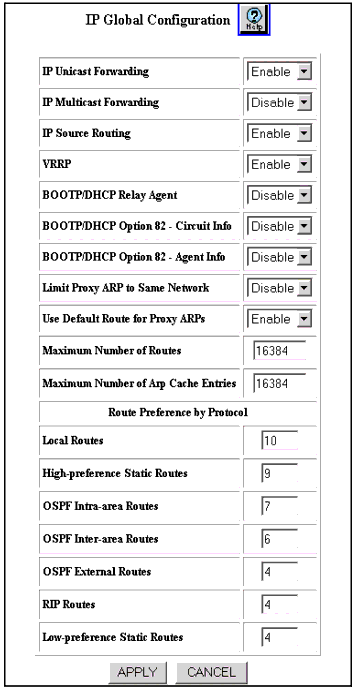|
|
|
To enable IP routing using the Web Agent:
Figure�95:�IP Global Configuration Web Page

| Parameter |
Description |
|---|---|
| IP Unicast Forwarding |
Disable IP Unicast Forwarding. Must be enabled for Unicast Forwarding. The default setting is Enable. |
| IP Multicast Forwarding |
Enable IP multicast forwarding on a global basis. Must be enabled for Multicast Routing or Forwarding. The default setting is Disable. |
| IP Source Routing |
Disable IP source routing globally. The default setting is Enable. |
| VRRP |
Disable VRRP globally. The default setting is Enable. |
| BOOTP/DHCP Relay Agent |
Enable Client requests for an IP address and forwards their requests to a server. This agent also relays responses from the server to the client. The default setting is Disable. |
| BOOTP/DHCP Option 82-Circuit Info |
Enable. This sub-option 82 identifies the slot and physical port number from which the DHCP request was received. The default setting is Disable. Note: This setting must be set to enable, and must be enabled on the desired IP interface (enabled by default). |
| BOOTP/DHCP Option 82- Agent Info |
Enable This sub-option 82 identifies the IP address and, if available, the system name of the switch. The Default setting is Disable. Note: This setting must be set to enable and must be enabled on the desired IP interface (enabled by default). |
| Limit Proxy ARP to Same Network |
Enable Proxy ARP on the same network. When enabled, the router responds to ARP requests when the source and target IP address are in the same IP network and different IP subnets. When disabled, the router responds to ARP requests when the source and target IP address are in different networks. The default setting is Disable. |
| Use Default Route for Proxy ARPs |
Disable the use of the default route on your switch as the route for Proxy ARPs. For example, if you have a default route configured to reach the 0.0.0.0 IP address, then any ARP request that does not match any of the other routes in your IP routing table will automatically go to this default route. The default setting is Enable. |
| Maximum Number of Routes |
Enter the maximum number of routes that you want added to the routing table. The default number of routes is 16384. Note: These routes refer only to IP Unicast entries. |
| Maximum Number of ARP Cache Entries |
Enter the maximum number of ARP cache entries. ARP entries refers to the space available for the ARP cache. When you increase the number of entries, it may cause the table to be relearned more frequently. Consequently, it will make address space usage more efficient. The default maximum number of entries is 16384. |
| Route Preference by Protocol |
This section describes the routing preferences set up according to the network administrator's preferences. These preferences are normally set up using the most to least trust. For example, local routes are normally considered to have more trust or a higher preference, while OSPF external routes are considered to have less trust or a lower preference. These preferences can be overridden, but careful consideration must be given when setting each. Note: Local Routes must always have the higher preference. Note: Do not change the Preferences unless you are certain of the consequences. Incorrect Preference settings can cause the switch to stop all routing. |
| Local Routes |
Enter a preference value for local routes. Note: Local Routes must always have the higher preference. |
| High-Preference Static Routes |
Enter a preference value for High preference static routes. |
| OSPF Intra-area Routes |
Enter an OSPF intra-area route. A lower number indicates a lower preference for the path. |
| OSPF Inter-area Routes |
Enter the inter-area paths to destinations in other OSPF areas. These are discovered through the examination of received summary Link State Advertisements (LSA). Enter a number to specify your path cost. A lower number indicates a lower preference for the path. |
| OSPF External Routes |
Enter the number of external paths to destinations external to the Autonomous System (AS). These are detected through the examination of received AS external LSAs. Enter a number to specify your path cost (preference). A lower number indicates a lower preference for the path. |
| RIP Routes |
Enter the number of RIP routes to use the hop count as a metric. To specify a preference for a RIP route, you must enter a lower number (path cost). |
| Low-Preference Static Routes |
Enter a preference value for Low preference static routes. |
|
|
|